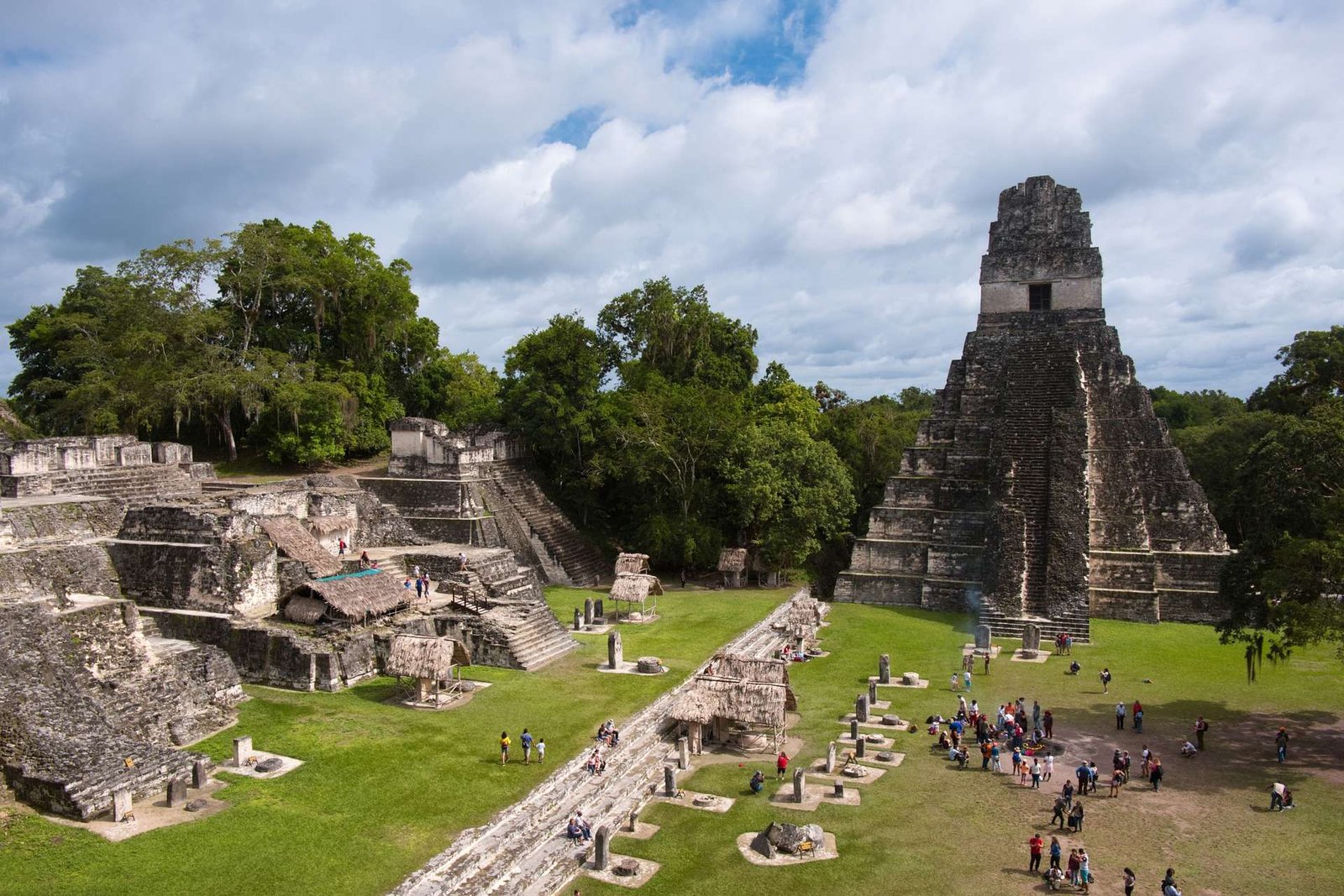The world is filled with mind-blowing man-made historical sites and wonders. With many breathtaking and incredible historical sites built by ancient civilizations, it’s sometimes hard to narrow down the best. Below is a list of the top 10 historical destinations for architecture enthusiasts. These sites showcase the rich architectural heritage of different civilizations and provide valuable insights into our shared human history.
Key Takeaways:
- Discover famous architectural landmarks from different civilizations.
- Visit must-visit historical sites that captivate the imagination.
- Explore iconic architectural marvels and wonders from history.
- Experience the best historical places for architecture lovers.
- Appreciate the historic architectural treasures and popular architectural landmarks around the world.
Machu Picchu
Located in southern Peru, Machu Picchu is a ruined city that was an important cultural center for the ancient Inca civilization. Rediscovered in 1911, it is famously called the “Lost City of the Incas.” Situated on top of a mountain, Machu Picchu offers breathtaking panoramic views of the surrounding Andes Mountains.
To reach Machu Picchu, visitors have the option of taking a scenic train ride or embarking on the challenging but rewarding Inca Trail hike. The Inca Trail allows travelers to experience the same pathways that the ancient Incas walked centuries ago, surrounded by stunning natural beauty.
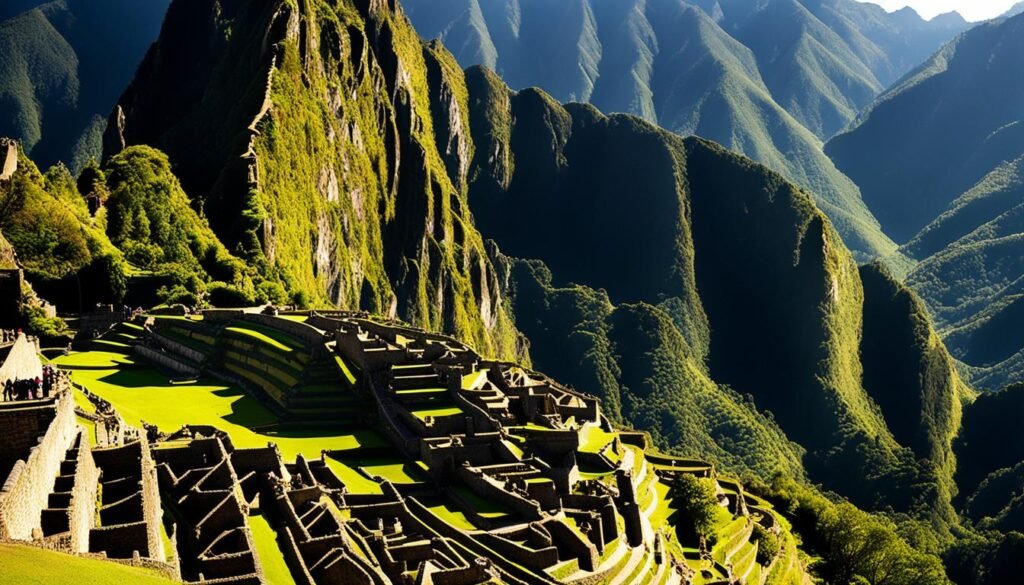
Designated as a UNESCO World Heritage Site in 1983, Machu Picchu is a testament to the advanced engineering and architectural skills of the Inca civilization. The meticulous construction of the stone structures and terraces, as well as the complex water management system, showcases the ingenuity of the ancient Incas.
Machu Picchu’s status as one of the New Seven Wonders of the World further solidifies its significance as a must-visit destination for history and architecture enthusiasts. Exploring the ancient ruins of Machu Picchu offers a unique opportunity to immerse oneself in the rich history and cultural heritage of the Inca civilization.
Overall, Machu Picchu is an awe-inspiring and spiritually uplifting experience, providing visitors with a deep appreciation for the ancient Inca civilization and their remarkable architectural achievements.
Interesting Facts about Machu Picchu:
- • Machu Picchu was constructed in the 15th century but abandoned by the Incas during the Spanish conquest. It remained hidden from the outside world until its rediscovery by Hiram Bingham in 1911.
- • Machu Picchu contains approximately 200 structures, including temples, houses, and agricultural terraces.
- • The Intihuatana stone, a ceremonial stone at Machu Picchu, is believed to have served as an astronomical calendar by the Incas.
- • The city was built using traditional Inca techniques, without the use of mortar, allowing the stone structures to withstand earthquakes and centuries of wear and tear.
Visitor Information:
| Location | Southern Peru, in the Cusco Region |
|---|---|
| Access | By train or hiking the Inca Trail |
| Best Time to Visit | May to September (dry season) |
| Entry Restrictions | Visitor numbers are limited, and entry permits must be obtained in advance. It is highly recommended to book tickets well in advance. |
| Ticket Information | Official tickets can be purchased online or through authorized travel agencies. |
| Additional Tips | Visitors are advised to acclimatize to the high altitude of Machu Picchu before attempting any hikes or long walks. |
Tikal
Tikal National Park in Guatemala is home to the largest and best-preserved ruins of the ancient Mayan civilization. The city-state centered here was a dominant force in the Mayan world during the Classic Period. Tikal offers a unique opportunity to explore the ruins in the midst of the jungle. It is a UNESCO World Heritage Site and provides a glimpse into the ancient Mayan culture and architectural achievements.
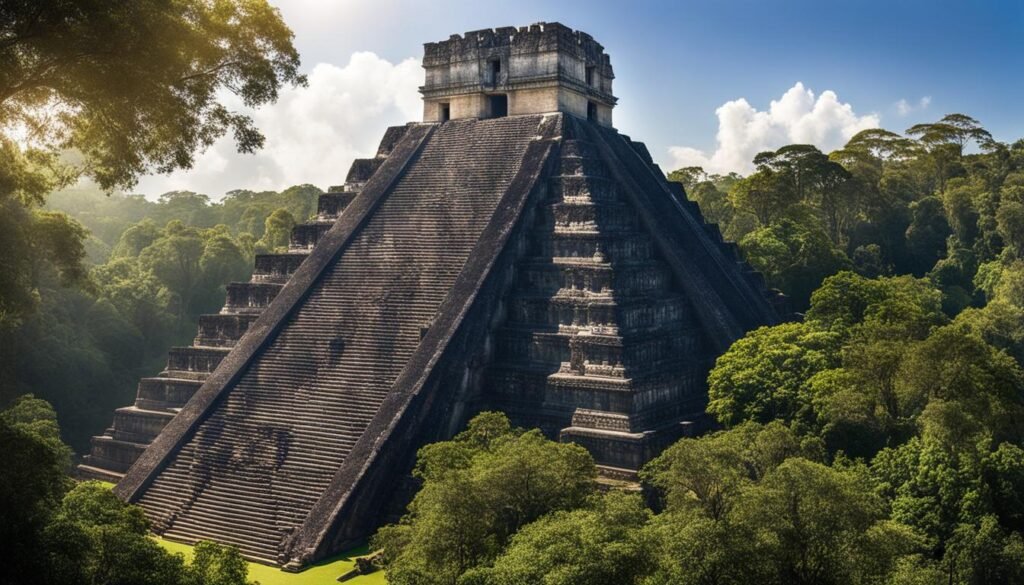
Located in the heart of Guatemala’s lush jungle, Tikal National Park reveals the impressive remnants of the ancient Mayan civilization. As you wander through the towering pyramids and intricate temple complexes, you can’t help but marvel at the architectural ingenuity of the Mayans. The stone structures, adorned with intricate carvings and surrounded by dense vegetation, transport you back in time to a civilization that thrived thousands of years ago.
A visit to Tikal allows you to immerse yourself in the fascinating history and culture of the Mayans. Explore the Great Plaza, where political and religious ceremonies took place, or climb to the top of Temple IV for a breathtaking panoramic view of the park. You’ll be amazed by the sheer size and grandeur of the temples, which served as centers of power and spirituality for the Mayan people.
“Tikal is a true testament to the ancient Mayan civilization’s architectural prowess and cultural significance. Walking among the ruins, you can’t help but feel a deep sense of awe and reverence for the achievements of this remarkable civilization.”
Tikal National Park’s inclusion as a UNESCO World Heritage Site further emphasizes its importance as a historical and cultural treasure. The designation recognizes its outstanding universal value and ensures its preservation for future generations to appreciate and learn from.
Whether you’re an architecture enthusiast or simply intrigued by ancient civilizations, Tikal is a must-visit destination. Immerse yourself in the mysteries of the Mayan world, explore the fascinating ruins, and gain a deeper understanding of this remarkable civilization’s architectural achievements.
The Pyramids at Giza
The Pyramids at Giza are a marvel of human engineering and one of the most famous architectural landmarks in the world. These pyramids were built over 3,000 years ago by the ancient Egyptians and continue to fascinate visitors today. The largest pyramid, known as the Great Pyramid, remains a mystery in terms of how it was constructed. The Pyramids at Giza are designated as a UNESCO World Heritage Site.
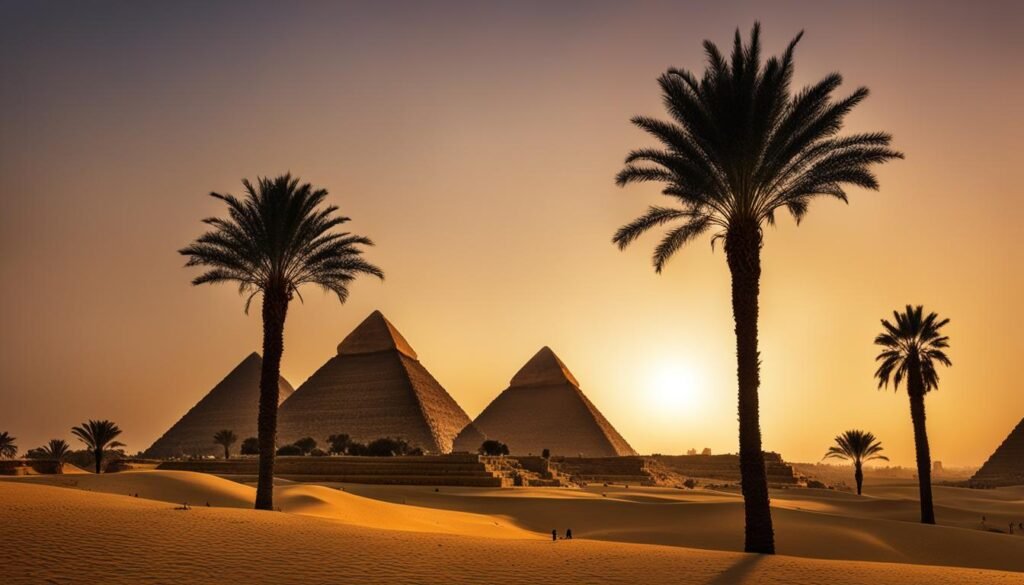
The Pyramids at Giza are a testament to the ingenuity and skill of the ancient Egyptian civilization. These monumental structures, built as tombs for pharaohs, showcase the innovative architectural techniques developed by the Egyptians. The Great Pyramid, built for Pharaoh Khufu, stands as the largest and most iconic pyramid at Giza. Its precise construction and precise alignment with the stars continue to awe and inspire.
“The Pyramids at Giza are a testament to the advanced knowledge and engineering capabilities of the ancient Egyptians. Their precise alignment, massive scale, and intricate design reflect an impressive level of planning and skill.” – Dr. Emily Johnson, Archaeologist
Visitors to the Pyramids at Giza can explore the complex and marvel at the awe-inspiring structures that have withstood the test of time. The pyramids are surrounded by other fascinating ancient Egyptian sites, such as the Sphinx and the Valley Temple of Khafre. These architectural wonders offer a glimpse into the ancient Egyptian civilization’s beliefs, rituals, and dedication to preserving their pharaohs’ legacy.
The Pyramids at Giza Quick Facts:
| Location | Country | Status |
|---|---|---|
| Giza | Egypt | UNESCO World Heritage Site |
| Includes the Great Pyramid, Pyramid of Khafre, Pyramid of Menkaure, Sphinx, and Valley Temple of Khafre | ||
| Construction Period | Architectural Style | Main Features |
| 2550 BC – 2490 BC | Ancient Egyptian | Massive stone blocks, precise alignment, complex internal passages |
Exploring the Pyramids at Giza offers a fascinating journey into the ancient Egyptian civilization, its monumental architecture, and religious beliefs. As a UNESCO World Heritage Site, it stands as a testament to our shared human history and the enduring legacy of one of the world’s greatest ancient civilizations.
Angkor Wat
Angkor Wat is an ancient city located in Cambodia, serving as the center of the mighty Khmer Empire. This historical site is home to the magnificent temple complex of Angkor Wat, the largest religious monument in the world. It stands as a remarkable testament to the architectural accomplishments of the Khmer civilization.
Exploring Angkor Wat provides visitors with a captivating glimpse into the rich history and vibrant culture of the Khmer Empire. From its intricate carvings to its grandeur, this UNESCO World Heritage Site showcases the architectural brilliance and artistic prowess of the ancient Khmer people.

“Angkor Wat is an architectural masterpiece, a symbol of the Khmer Empire’s grandeur.” – Archaeology Magazine
The temple complex of Angkor Wat is not only a historical treasure but also a place of spiritual significance. It offers a serene sanctuary where visitors can reflect on the past and appreciate the profound cultural heritage of Cambodia.
Khmer Empire and Angkor Archaeological Park
The Khmer Empire flourished from the 9th to the 15th centuries, leaving a lasting legacy in Southeast Asia. Angkor Wat served as the capital city during the height of the empire’s power. Today, the Angkor Archaeological Park spans over 400 square kilometers and features numerous temples, reservoirs, and other archaeological sites.
UNESCO World Heritage Site
In recognition of its historical and cultural significance, Angkor Wat was designated as a UNESCO World Heritage Site in 1992. This prestigious title highlights the importance of preserving and safeguarding this architectural marvel for future generations.
Plan Your Visit to Angkor Wat
When visiting Angkor Wat, be sure to explore the intricacies of the temple complex, witness breathtaking sunrises and sunsets over the iconic structures, and immerse yourself in the ancient atmosphere that permeates this extraordinary site.
To optimize your experience, consider hiring a knowledgeable guide who can provide insights into the history, mythology, and hidden gems of Angkor Wat. Additionally, don’t forget to respect the cultural and religious significance of the site by adhering to the rules and regulations in place.
Embark on a journey through time and marvel at the architectural wonders of Angkor Wat, a destination that truly captivates the imagination and offers a deeper understanding of the Khmer Empire’s remarkable achievements.
Petra
Petra, an ancient city in Jordan, is a fascinating archaeological site that dates back to the 6th century BC. Carved into a canyon, this extraordinary city is known for its unique rock-cut architecture and intricate carvings. Rediscovered in the early 19th century, Petra was once a thriving city but was eventually abandoned and forgotten until its remarkable rediscovery.
Today, Petra is recognized as a UNESCO World Heritage Site and is also one of the New Seven Wonders of the World. Exploring this awe-inspiring destination allows visitors to step back in time and marvel at the ingenuity and craftsmanship of the ancient civilizations that once called Petra home.
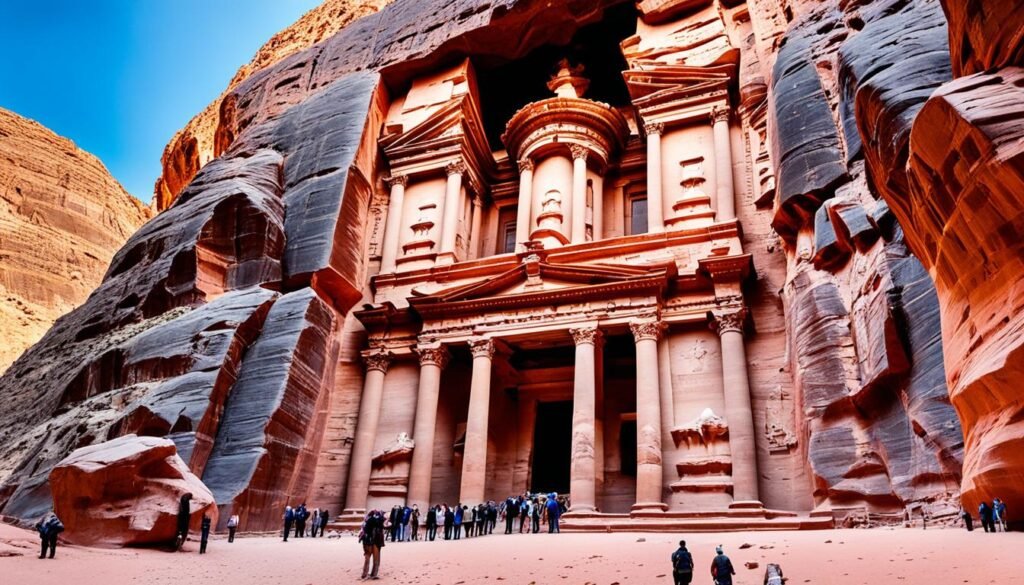
As you venture through its narrow passages and towering facades, you’ll be captivated by the rich history and architectural wonders that await you. Petra’s iconic Treasury, the impressive Monastery, and the intricately detailed Royal Tombs are just a few of the incredible sights that make this ancient city truly unforgettable.
Petra Highlights:
- Unique rock-cut architecture
- Intricate carvings and facades
- The iconic Treasury
- The impressive Monastery
- The intricately detailed Royal Tombs
| Location | Country | Designation |
|---|---|---|
| Petra | Jordan | UNESCO World Heritage Site |
Whether you’re an architecture enthusiast, history buff, or simply seeking a unique travel experience, Petra is an absolute must-visit. Immerse yourself in the ancient wonders and vibrant history of this extraordinary city and create memories that will last a lifetime.
Stonehenge
Stonehenge, a megalithic structure in England, is a UNESCO World Heritage Site that holds a rich history dating back over 3,000 years. This iconic landmark consists of massive stones arranged in a circular pattern, captivating both researchers and visitors alike with its enigmatic origins and purpose.
Believed to have been used for religious or ceremonial practices, Stonehenge continues to intrigue and inspire awe. Its architectural design and construction techniques showcase the ingenuity of ancient civilizations, serving as a symbol of their remarkable achievements.
Visiting Stonehenge provides a unique opportunity to witness the enduring legacy of human creativity. As you stand among the towering stones, you can’t help but be transported back in time, marveling at the sheer magnitude and mystery of this megalithic structure.
Take a moment to reflect on the significance of Stonehenge and the cultural heritage it represents. Let the aura of this ancient monument wash over you, immersing yourself in the awe-inspiring atmosphere of this UNESCO World Heritage Site.
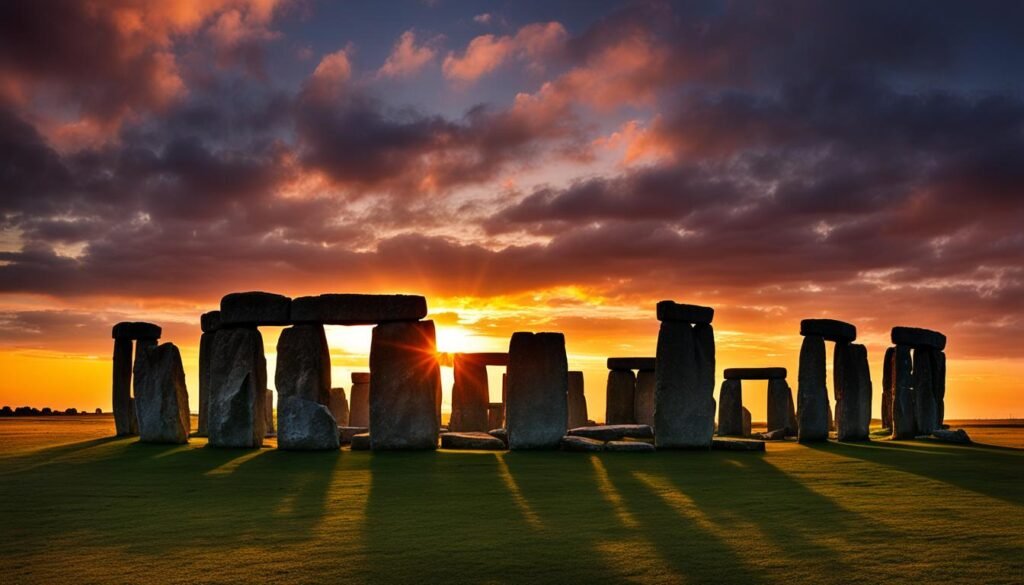
Quotes:
“Stonehenge is a architectural marvel that continues to defy explanation. Its timeless presence leaves us in awe of the ancient world and the mysteries it holds.” – Archaeologist Jane Reynolds
Fascinating Facts about Stonehenge:
- Stonehenge is aligned with the movements of the sun, suggesting a connection with ancient rituals and celestial observations.
- The largest stones at Stonehenge, known as sarsens, weigh up to 25 tons and were transported from over 20 miles away.
- The bluestones, smaller stones that make up part of the monument, were quarried in Wales and transported over 150 miles to the site.
- Stonehenge attracts over a million visitors each year, making it one of the most popular historical sites in the world.
Explore the mysteries of Stonehenge, uncovering the secrets of our ancient past and immersing yourself in the wonder of this iconic megalithic structure.
The Colosseum and Forum
The Colosseum and Forum in Rome are iconic symbols of ancient Rome’s grandeur and architectural achievements. The Colosseum, also known as the Flavian Amphitheatre, was the largest amphitheater in the Roman Empire. It was a magnificent structure used for gladiatorial contests, animal hunts, and other public spectacles. Today, it stands as a testament to the engineering and artistic prowess of ancient Rome.
The Roman Forum, located nearby, was the heart of the ancient city. It served as the center of public life and administration, a place where citizens gathered to conduct business, engage in political discussions, and attend religious ceremonies. The Forum is home to various ruins and temples, including the Temple of Saturn, Basilica Aemilia, and the Arch of Septimius Severus.
Exploring the Colosseum and Forum allows visitors to step back in time and immerse themselves in the rich history of ancient Rome. These sites provide invaluable insights into the daily life, culture, and architecture of one of the greatest empires in history. It’s no wonder that they are designated as UNESCO World Heritage Sites, preserving their historical and cultural significance for future generations.
Key Features of The Colosseum and Forum:
- The Colosseum: The largest amphitheater in the Roman Empire, hosting various spectacles and events.
- The Roman Forum: The political, social, and religious center of ancient Rome.
- Historical Significance: Offers valuable insights into the architecture, culture, and daily life of ancient Rome.
- UNESCO World Heritage Sites: Recognized for their outstanding universal value and cultural importance.
The Parthenon
The Parthenon, located atop the Acropolis in Athens, Greece, is a remarkable temple that stands as a testament to the ancient Greek civilization. Built in the 5th century BC, this architectural masterpiece is considered one of the most iconic examples of Classical Greek architecture.
The Parthenon’s design showcases the Greeks’ mastery of proportions and their emphasis on harmony and balance. The temple is renowned for its towering marble columns and intricate friezes, which depict scenes from Greek mythology and historical events. Its beauty and elegance continue to captivate visitors from around the world.
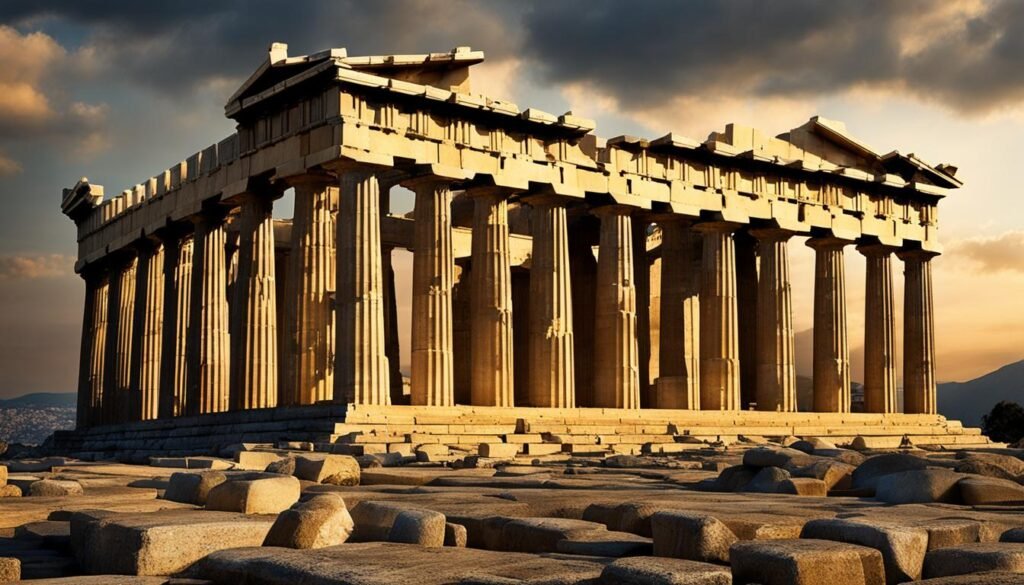
Designated as a UNESCO World Heritage Site, the Parthenon holds immense cultural and historical significance. It served as a symbol of Athenian democracy and the city’s cultural and intellectual achievements. Today, it serves as a powerful reminder of the enduring legacy of ancient Greek civilization.
Easter Island
Easter Island, also known as Rapa Nui, is a remote island in the Pacific Ocean that holds a mystical appeal for travelers. This captivating destination is famous for its ancient Moai statues, which stand tall and mysterious against the island’s rugged landscape. The Moai statues were created by the ancient Rapa Nui civilization and continue to intrigue visitors with their enigmatic origins and purpose. Carved from volcanic rock, these sculptures have become iconic symbols of Easter Island and its rich cultural heritage.
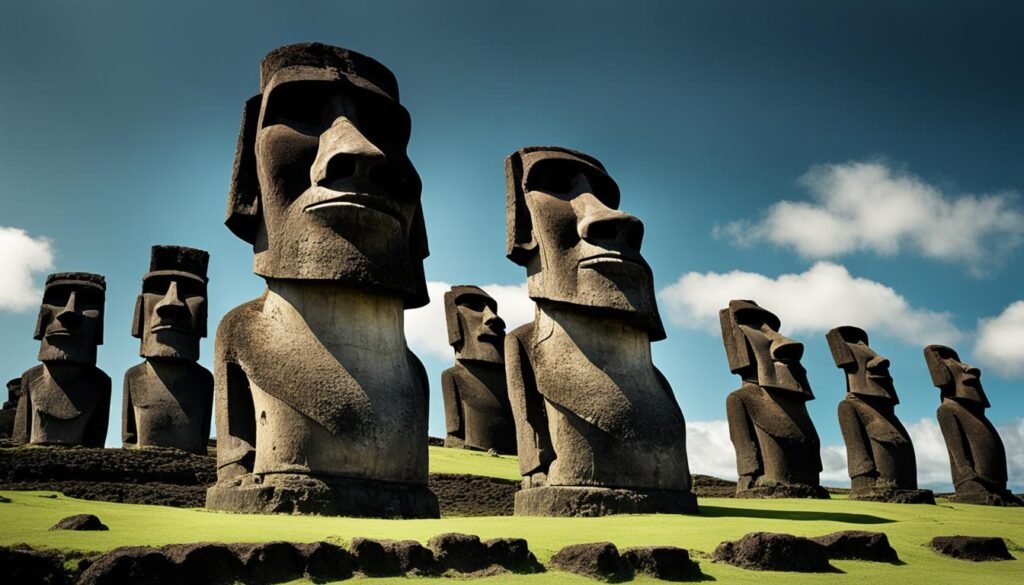
Easter Island is recognized as a UNESCO World Heritage Site and offers a unique architectural and cultural experience. Exploring the island’s archaeological sites, visitors can witness the impressive craftsmanship and artistic vision that went into creating these monumental sculptures. The Rapa Nui National Park, which encompasses the entire island, preserves and protects the Moai statues, as well as other archaeological treasures, providing invaluable insight into the island’s ancient civilization.
“Visiting Easter Island is like stepping into a world shrouded in mystery. The sight of the Moai statues standing guard over the island is awe-inspiring and leaves a lasting impression.” – Traveler testimonial
In addition to the captivating statues, Easter Island offers visitors the chance to immerse themselves in the unique Polynesian culture that still thrives on the island today. From traditional music and dance performances to local crafts and cuisine, there’s no shortage of opportunities to connect with the island’s vibrant heritage.
Key Highlights of Easter Island:
- Exploring the ancient Moai statues and witnessing their impressive size and craftsmanship
- Visiting the Rapa Nui National Park, a UNESCO World Heritage Site
- Immersing oneself in the local Polynesian culture
- Witnessing mesmerizing sunsets and tranquil beaches
A trip to Easter Island is a journey into the depths of history, where visitors can discover the fascinating story of the Rapa Nui civilization and its remarkable architectural achievements. Whether it’s the allure of the Moai statues or the island’s natural beauty, Easter Island offers an unforgettable experience that will leave a lasting impression.
Taj Mahal
The Taj Mahal, an architectural masterpiece of the Mughal Empire, is a symbol of eternal love. Constructed in the 17th century, this stunning mausoleum was built by Emperor Shah Jahan in memory of his beloved wife, Mumtaz Mahal. The Taj Mahal is an exquisite blend of Mughal, Persian, and Islamic architectural styles, showcasing intricate carvings, delicate marble inlays, and mesmerizing geometric patterns.
This UNESCO World Heritage Site is renowned for its grandeur and beauty. The majestic white marble façade shines brilliantly in the sunlight and changes color throughout the day. The Taj Mahal’s symmetrical layout and reflecting pool create a sense of harmony and tranquility, enhancing its ethereal charm.
The gardens surrounding the Taj Mahal are meticulously manicured and provide a serene atmosphere for visitors to immerse themselves in the stunning surroundings. Walking through the ornate gateways and exploring the intricate details of the mausoleum is a truly awe-inspiring experience.
“The Taj Mahal rises above the banks of the river like a solitary tear suspended on the cheek of time.” – Rabindranath Tagore
Key Features of the Taj Mahal:
- The main building is made of white marble, symbolizing purity and eternal beauty.
- Intricate calligraphy adorns the exterior walls, with verses from the Quran delicately inscribed.
- The central dome is a masterpiece of engineering, standing tall and majestic.
- Meticulously designed gardens include water channels and fountains, adding to the visual appeal.
- The interior of the mausoleum houses the cenotaphs of Shah Jahan and Mumtaz Mahal.
Visiting the Taj Mahal is a journey through history and an opportunity to marvel at the unparalleled craftsmanship and architectural brilliance of the Mughal Empire. Delve into the rich cultural heritage of India and witness the timeless beauty of the Taj Mahal, an enduring testament to love and architectural prowess.
Conclusion
Exploring historical architecture destinations is an enriching experience for architecture lovers. The top 10 historical destinations offer a glimpse into the iconic architectural marvels and architectural wonders from history. From the majestic Machu Picchu to the timeless Taj Mahal, these must-visit historical sites showcase the best historical places for architecture enthusiasts to explore.
Each historical destination holds its own unique charm and historical significance. Imagine standing in awe of the Pyramids at Giza, marveling at their grandeur, and feeling a sense of wonder at the engineering prowess of the ancient Egyptian civilization. Or wandering through the ancient ruins of Tikal, surrounded by the lush jungle of Guatemala, and being transported back in time to the mighty Mayan empire.
These historic architectural treasures serve as a reminder of the rich heritage of humanity and the incredible achievements of our ancestors. Whether it’s the ancient city of Petra in Jordan with its breathtaking rock-cut architecture or the mysterious Moai statues on Easter Island, each site offers a glimpse into the architectural wonders of the past.
Visiting these popular architectural landmarks around the world allows architecture enthusiasts to appreciate the beauty and craftsmanship of ancient civilizations. It is an opportunity to gain a deeper understanding of our collective history and to be inspired by the architectural marvels that have stood the test of time.
FAQ
What is Machu Picchu?
Machu Picchu is a ruined city in southern Peru that was an important cultural center for the Inca civilization. It is famously known as the “Lost City of the Incas” and is accessible by train or hiking the Inca Trail. It is recognized as a UNESCO World Heritage Site and one of the New Seven Wonders of the World.
What is Tikal?
Tikal is a national park in Guatemala that is home to the largest and best-preserved ruins of the ancient Mayan civilization. It offers an opportunity to explore the ruins in the midst of the jungle and provides valuable insights into the ancient Mayan culture and architectural achievements. Tikal is a UNESCO World Heritage Site.
What are the Pyramids at Giza?
The Pyramids at Giza are ancient Egyptian structures and one of the most famous architectural landmarks in the world. They were built over 3,000 years ago and continue to fascinate visitors with their engineering marvels. The largest pyramid, known as the Great Pyramid, remains a mystery in terms of its construction. The Pyramids at Giza are designated as a UNESCO World Heritage Site.
What is Angkor Wat?
Angkor Wat is an ancient city in Cambodia that was the center of the Khmer Empire. The temple complex of Angkor Wat is the largest religious monument in the world and showcases the architectural accomplishments of the Khmer civilization. It offers a glimpse into the rich history and culture of the empire and is recognized as a UNESCO World Heritage Site.
What is Petra?
Petra is an archaeological site located in Jordan and dates back to the 6th century BC. It is known for its rock-cut architecture and intricate carvings. Once a thriving city, Petra was abandoned and forgotten until its rediscovery. Today, it is recognized as a UNESCO World Heritage Site and one of the New Seven Wonders of the World.
What is Stonehenge?
Stonehenge is a megalithic structure in England that is over 3,000 years old. It consists of massive stones arranged in a circular pattern and is believed to have been used for religious or ceremonial purposes. Stonehenge continues to intrigue researchers and visitors with its mysterious origins and purpose. It is a UNESCO World Heritage Site.
What are the Colosseum and Forum?
The Colosseum and Forum are iconic symbols of ancient Rome’s grandeur and architectural achievements. The Colosseum was the largest amphitheater in the Roman Empire, while the Roman Forum was the center of public life and administration. These sites provide a glimpse into the ancient Roman civilization and are designated as UNESCO World Heritage Sites.
What is the Parthenon?
The Parthenon is a temple located atop the Acropolis in Athens, Greece. It is one of the most famous examples of Classical Greek architecture and a symbol of the ancient Greek civilization. Built in the 5th century BC, the Parthenon continues to inspire awe with its marble columns and exquisite design. It is designated as a UNESCO World Heritage Site.
What is Easter Island?
Easter Island, also known as Rapa Nui, is a remote island in the Pacific Ocean known for its enigmatic Moai statues. These towering stone statues were created by the ancient Rapa Nui civilization and continue to captivate visitors with their mysterious origins and purpose. Easter Island is a UNESCO World Heritage Site and offers a unique architectural and cultural experience.
What is the Taj Mahal?
The Taj Mahal is a mausoleum located in India and a testament to the architectural genius of the Mughal Empire. Built in the 17th century, it is dedicated to the wife of Emperor Shah Jahan. The Taj Mahal showcases white marble façade, intricate carvings, and beautiful gardens. It is a UNESCO World Heritage Site and one of the most iconic landmarks in the world.

